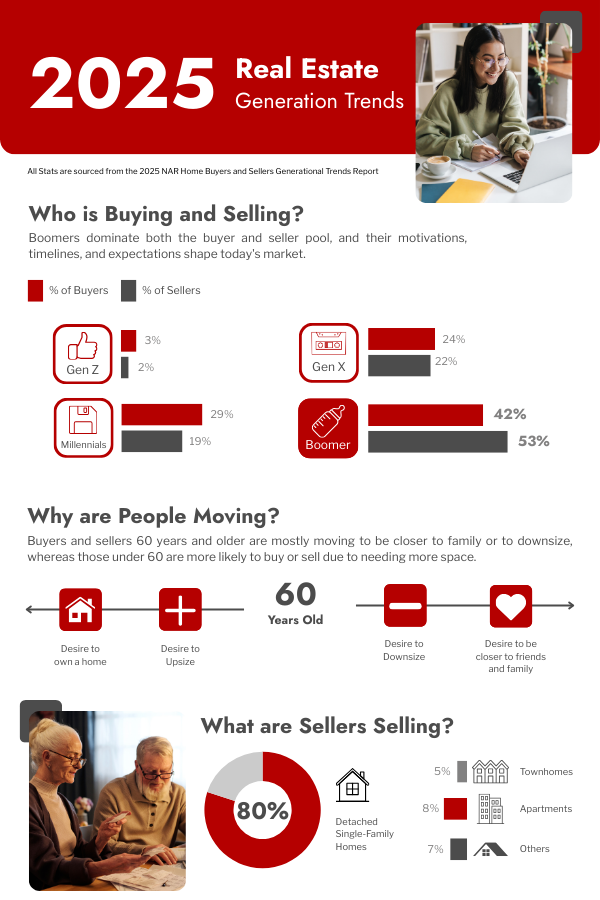Who is driving the U.S. housing market in 2025? It is not just interest rates or the supply of homes. The most powerful force at work is demographic change. Baby Boomers are releasing decades of equity, Millennials are searching for affordability and transit-connected living, Gen X is fueling demand for multi-generational housing, and Gen Z is entering the market with digital-first expectations.
At The BTR Group, we view these shifts as more than short-term trends. They are signals of how resilient communities will be built and sustained over the next decade.
Baby Boomers and Real Estate Listings in 2025
Baby Boomers now account for more than half of today’s sellers, according to the National Association of Realtors 2025 Generational Trends Report. Many are downsizing, relocating closer to family, or choosing lower-maintenance housing. Most of these homes are larger, older, and located outside primary job centers.
Investment takeaway:
Boomer listings create two kinds of opportunities. Suburban and exurban areas may see targeted acquisition strategies, while older homes offer potential for adaptive reuse into multi-family or mixed-use projects. Communities that encourage energy-efficient retrofits will be especially attractive to capital.
Millennials and the Housing Affordability Gap
Millennials now represent 28 percent of U.S. buyers, with younger Millennials making up the majority of first-time purchasers (NAR 2025). Despite being highly educated, many face affordability challenges. According to MarketWatch, Millennials often compromise on price, home condition, and commuting distance.
Investment takeaway:
Developers who can provide smaller, energy-efficient, and transit-accessible housing will capture strong Millennial demand. Shared-equity housing and public-private partnerships may also help address the affordability gap while strengthening neighborhood stability.
Gen X and the Growth of Multi-Generational Homes
Gen X buyers are driving demand for multi-generational living. Nearly 20 percent of their purchases now include extended family households, according to the NAR 2025 Generational Report. This reflects both financial realities and cultural preferences for shared living arrangements.
Investment takeaway:
Properties with flexible layouts, larger lots, or accessory dwelling units (ADUs) are becoming more valuable. Municipalities that adjust zoning rules to allow ADUs will attract both families and investment capital.
Gen Z and Digital-First Expectations
Gen Z currently represents only about 3 percent of buyers, but their influence is growing. These younger buyers tend to choose older, more affordable homes and often rely on professional guidance. At the same time, they expect transparency and digital-first interactions (NY Post, 2025).

Investment takeaway:
Gen Z will favor platforms and brokerages that integrate AI tools, digital education, and transparent processes. Their purchase patterns may also provide early signals of neighborhoods on the verge of revitalization.
Policy and Market Forces in 2025
Generational change does not exist in isolation. It interacts with broader housing policies and infrastructure trends. Federal climate initiatives are encouraging energy retrofits. Affordability challenges are driving experiments with shared-equity programs and housing subsidies. Municipalities are beginning to discuss zoning reform to expand multi-generational housing options.
Transit access and proximity to healthcare facilities are also shaping where demand will concentrate. The ULI and PwC Emerging Trends in Real Estate 2025 report identifies these dynamics as central to long-term resilience in U.S. housing markets.
Conclusion
The U.S. housing market in 2025 is being reshaped by generational change. Baby Boomers are unlocking capital through downsizing. Gen X is fueling demand for multi-generational living. Millennials are highlighting the affordability gap. Gen Z is bringing digital-first expectations to the market.
Together, these shifts are redefining not only who is buying and selling but also how communities grow and adapt. For investors, developers, and policymakers, the lesson is clear: demographic forces create both challenges and opportunities. By aligning strategies with the needs of each generation, stakeholders can build resilient communities and long-term value.
References
- NAR 2025 Home Buyers and Sellers Generational Trends Report (PDF)
- NAR Generational Trends Overview Page
- ULI and PwC Emerging Trends in Real Estate 2025
- ULI Americas Emerging Trends Report Page
- MarketWatch on First-Time Home Buyers
- Wall Street Journal on Home Sales Data
- Business Insider on Housing Market Outlook
- Investopedia on Boomer Dominance in Housing
- NY Post on Gen Z Savings and Homeownership
Disclaimer: The views and information in this post are for general information only. They do not constitute investment, legal, accounting, or tax advice, and are not an offer or solicitation for any security or service. Some data may come from third-party sources believed to be reliable, but BTR Group does not guarantee accuracy or completeness. Past performance is not indicative of future results. Please consult your professional advisers before acting on any information here.
